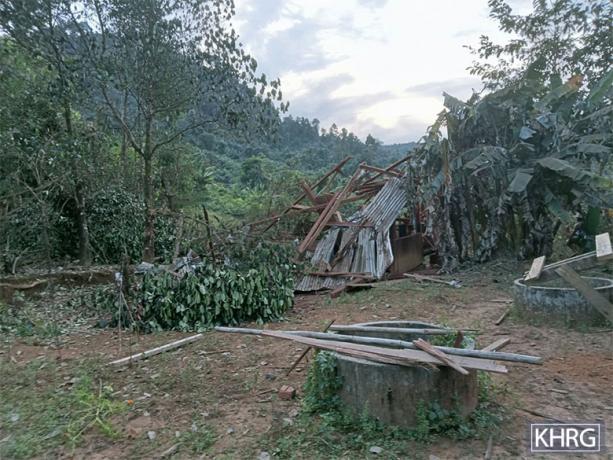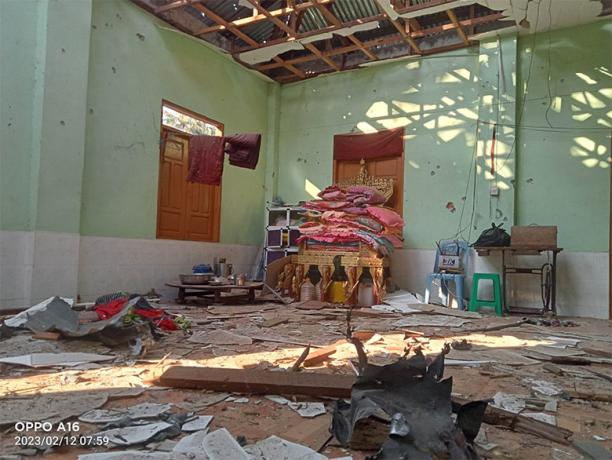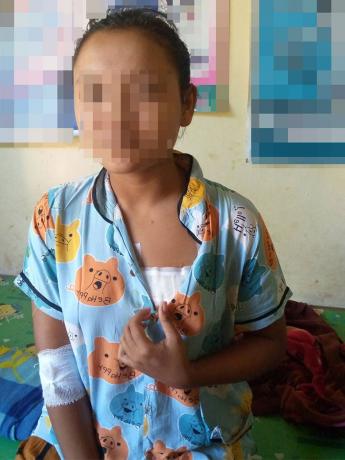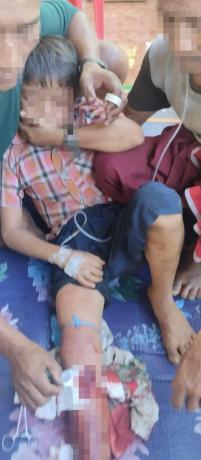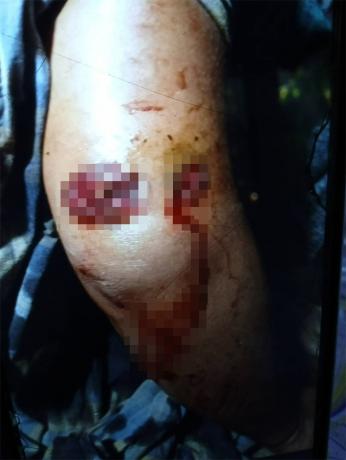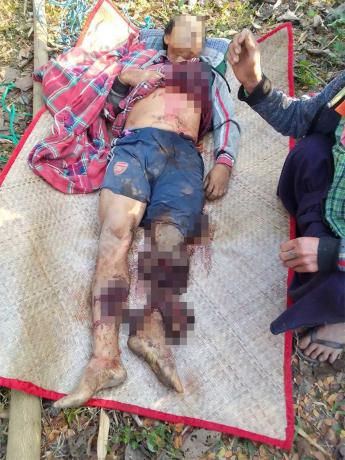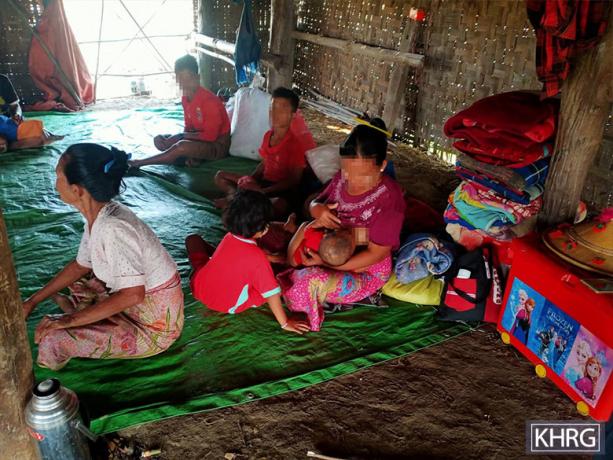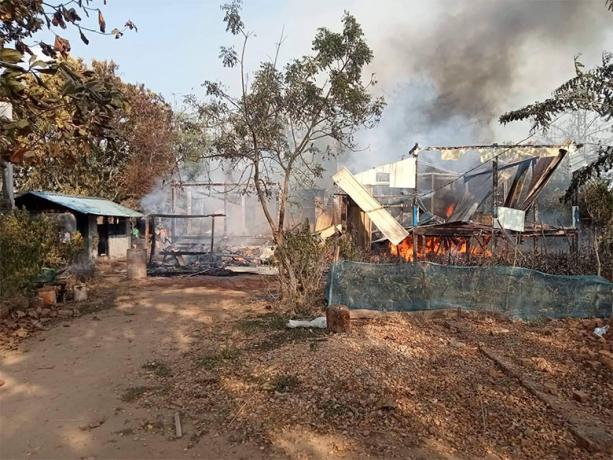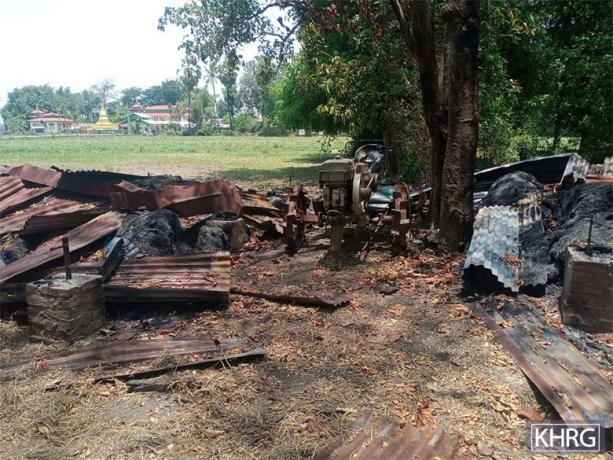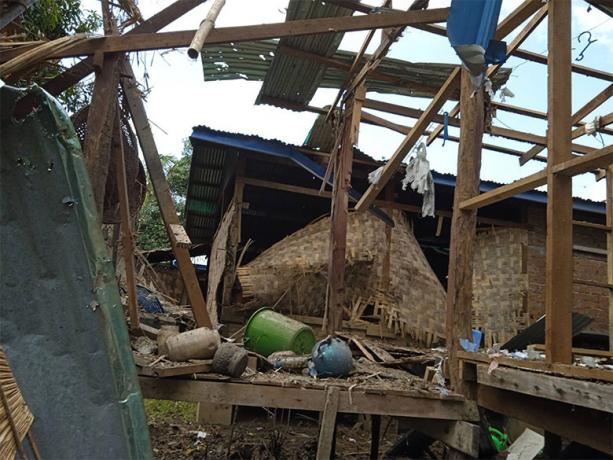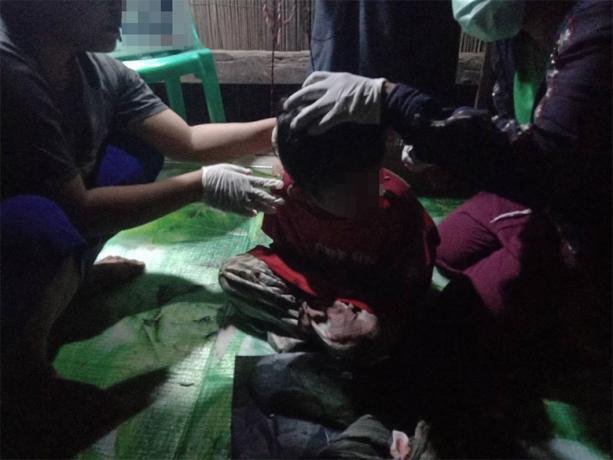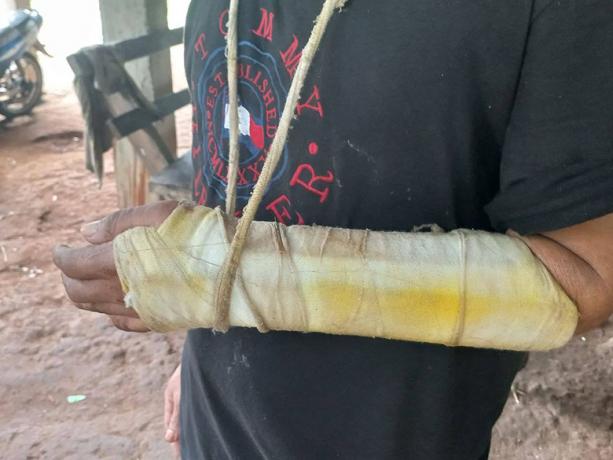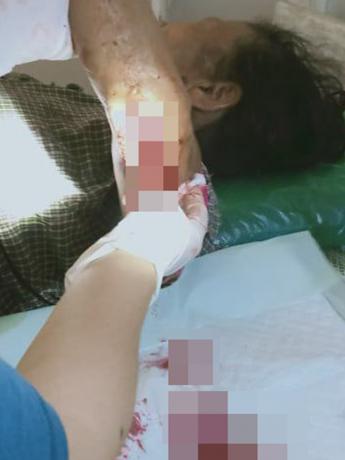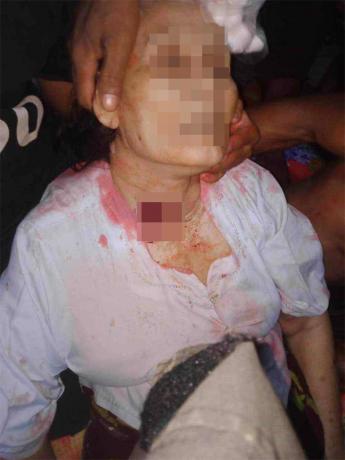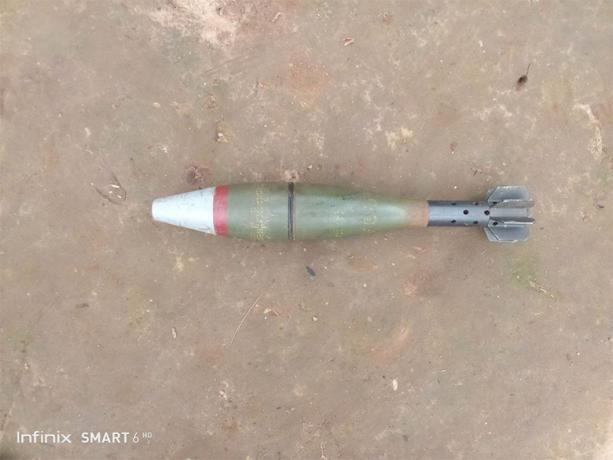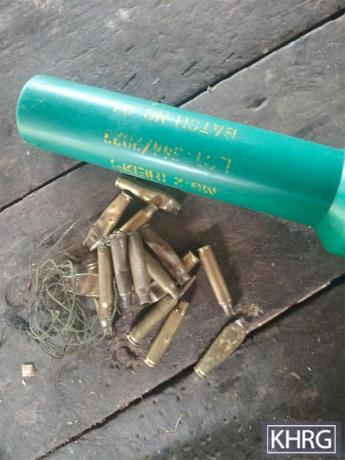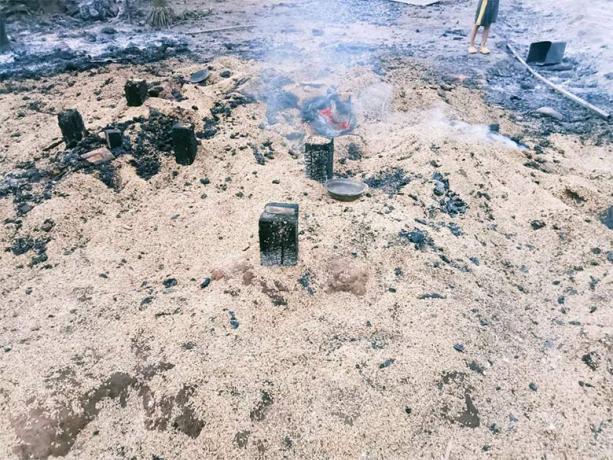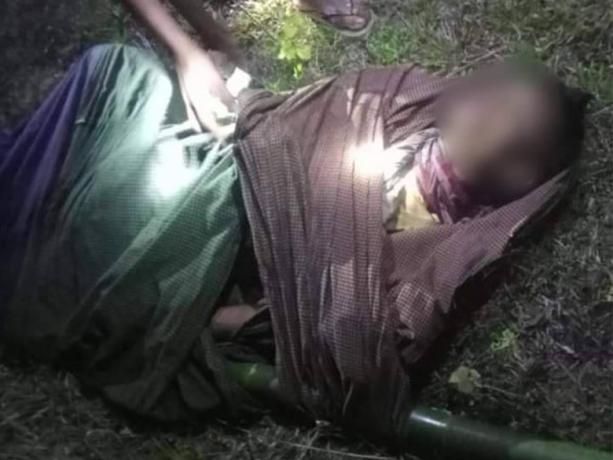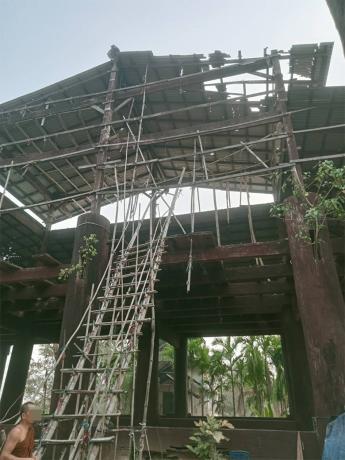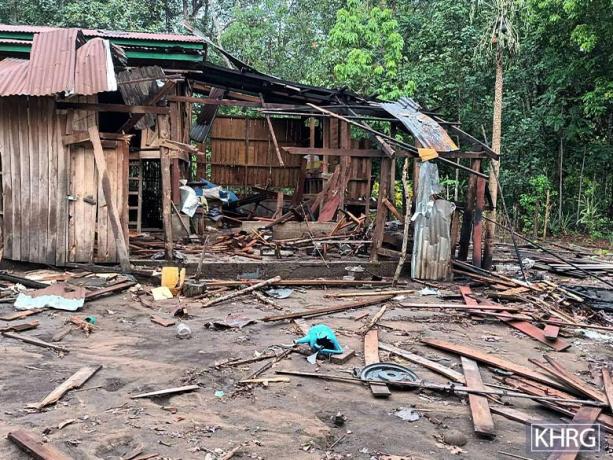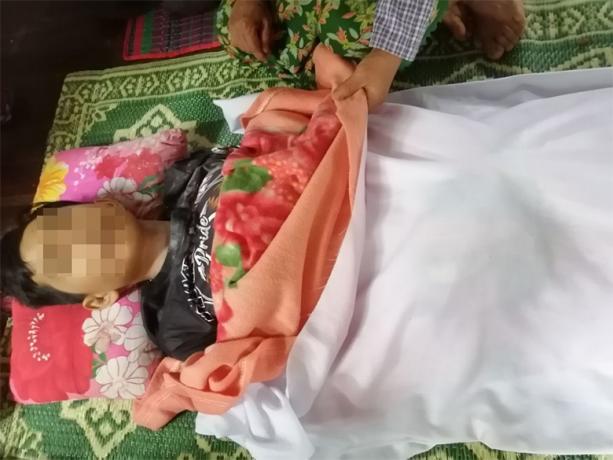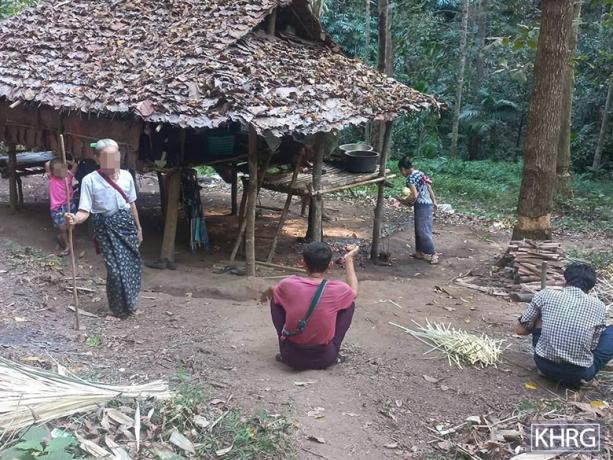This Photo Set shows photographic evidence of State Administration Council (SAC) indiscriminate shelling into civilian areas, communities, and plantations, from January 2023 to February 2024. During the reporting period, KHRG has received extensive information on SAC indiscriminate shelling and its consequences on villagers’ lives; one of the largest reported issues since the 2021 coup. KHRG has received more than 2,708 photos of the destruction and harm caused by SAC shelling between January 2023 and February 2024, from Doo Tha Htoo (Thaton), Taw Oo (Toungoo), Kler Lwee Htoo (Nyaunglebin), Mergui-Tavoy, Mu Traw (Hpapun) and Dooplaya Districts. SAC soldiers indiscriminately shelled mortars into the areas surrounding their army camps on a daily basis, especially in regions with active conflict. A high number of mortar rounds landed inside villages, farms and plantations, on community roads, and inside the compounds of medical clinics, churches, and schools.
As a result, this shelling killed and wounded villagers, destroyed civilian houses, buildings, and plantations, and caused massive displacement. These attacks also caused persistent fear, restricted access to education and healthcare, and increased the risk of unexploded ordnance (UXOs) contamination in civilian areas. Villagers cannot work on their farms and plantations to secure their livelihoods. Villagers have sought refuge in the jungle, in caves, and inside nearby monasteries, as SAC soldiers targeted villages and civilian houses. However, on several occasions, SAC soldiers also shelled monasteries’ compounds and surrounding areas. Nowhere is safe for villagers in Southeast Burma.
Photo Set: SAC indiscriminate shelling in Southeast Burma, and its impacts on villagers, January 2023 to February 2024
Some of the 2,708 photos on the impacts of shelling, received between January 2023 to February 2024, were taken by local villagers and some of them were taken by community members who have been trained by KHRG to monitor the human rights situation in their local area. This Photo Set includes 61 of these photos, from six districts in locally-defined Karen State[1], as evidence of immediate and protracted impacts faced by local villagers in the aftermath of State Administration Council (SAC)[2] indiscriminate and targeted shelling in civilian areas.
Further background reading on the situation on SAC indiscriminate shelling in Southeast Burma/Myanmar can be found in the following KHRG reports:
- “Dooplaya District Situation Update: Fighting, SAC shelling, abusive construction projects, and education, healthcare and livelihood challenges in Kaw T’Ree Township (April to June 2023).”, May 2024.
- “Doo Tha Htoo District Situation Update: SAC shelling into villages in Tha Htoo Township, causing injuries and destruction (September 2022 to February 2023)” March 2024.
- “Taw Oo District Situation Update: Fighting, shelling, and house burning in Thandaung Town, and air strikes in Htaw Ta Htoo Township (January to July 2023)” January 2024.
- “Mu Traw District Situation Update: SAC air strikes, arrest of villagers, and indiscriminate shelling causing casualties, and landmine explosion, March 2022 to February 2023”, January 2024.
- Striking Fear: Impacts of State Administration Council (SAC) shelling on villagers’ lives in Southeast Burma (January to October 2023), December 2023.
This photo was taken on January 2nd 2023 in A--- village, Khaw Hpoe Pleh village tract, Bilin Township, Doo Tha Htoo District. This photo shows damage caused by SAC shelling of 122mm mortar rounds from January 1st to 2nd 2023. Rounds were shelled by SAC soldiers based in Tha Gaw Play army camp. Five rounds landed in A--- village area, causing destruction and damage to villagers’ huts, houses, a church, farms, and rubber plantations. SAC shelled mortar rounds again on February 7th 2023, damaging seven houses, and villagers’ properties inside. [Photo: KHRG]
These photos were taken on February 12th 2023, in B--- village, Shwe Yaung Pya village tract, Tha Htoo Township, Doo Tha Htoo District. These photos show the damages caused by SAC Light Infantry Battalion (LIB)[3] #9, who indiscriminately shelled mortar rounds in the area. Three shells landed in the monastery compound, in B--- village, on February 11th, at 8:37 pm. Due to the explosions, three monks were injured and the monastery buildings and materials were destroyed. SAC LIB #9 is based in Win Pa army camp, under the command of Light Infantry Division (LID)[4] #44. [Photos: Local villager]
This photo was taken on March 20th 2023 in C--- village, Ah Lu village tract, Kyeh Htoh Township, Doo Tha Htoo District. It shows a villager named U[5] D--- who was killed by shrapnel from SAC shelling. On that day, SAC Artillery Unit #602, under Light Infantry Division (LID) #44, shelled 120mm mortar rounds in C--- village and one landed beside U D---’s house. U D---’s wife also sustained a minor injury from shrapnel. [Photo: KHRG]
This photo was taken on October 19th 2023 in E--- village, Hsaw Thu Hkee village tract, Kyeh Htoh Township, Doo Tha Htoo District. On that day, mortar shells were fired by SAC Light Infantry Battalion (LIB) #2, from Thaton Town army camp, based at Let Pan Pin temporary camp in E---. This photo shows a villager named Naw[6] F--- who was seriously injured by shrapnel on her head while she was in her village. [Photo: Local villager]
This photo was taken on November 16th 2023 in G--- village, Hpa-an Township, Doo Tha Htoo District. The photo shows the crater left by an SAC mortar round that landed beside a villager’s house, on a farm on November 15th 2023. The shells damaged a house and household materials and killed two cattle. [Photo: Local villager]
This photo was taken on November 20th 2023, in H--- village, Shwe Laung Aye village tract, Bilin Township, Doo Tha Htoo District. This photo shows an injured villager named Naw I--- (17 years old) accessing medical treatment at H--- clinic. She was injured by SAC Light Infantry Battalion (LIB) #404 shelling of several 60mm mortar rounds around their army base in H--- village area, on November 20th 2023. These attacks also injured another villager, and damaged villagers’ houses and properties. SAC LIB #404 is under Military Operation Command (MOC)[7] #8. [Photo: Local villager]
This photo was taken on December 7th 2023 in J--- village, Eee Heh village tract, Hpa-an Township, Doo Tha Htoo District. This photo shows the damage caused by the SAC shelling of mortar rounds, that landed on the roof of a house, on December 5th 2023. The roof was destroyed by the explosion. [Photo: KHRG]
This photo was taken on January 19th 2024 in K--- village, Daw Ya village tract, Tha Htoo Township, Doo Tha Htoo District. On that day, SAC Artillery Unit #314 shelled mortar rounds and two rounds landed in K--- village. Shrapnel from the shells’ explosion killed four women and injured six other villagers, including a two-year-old boy. The shelling also destroyed two houses and damaged five houses, two school buildings, one monastery building and the village’s main water storage. [Photos: Local villager]
The top photo was taken on January 18th and the photo on the right was taken on February 1st 2024 in L--- village, Kaw Ler village tract, Tha Htoo Township, Doo Tha Htoo District. On January 18th, SAC LIB #9, based in Win Pa army camp in Thaton Town, shelled mortar rounds in the area surrounding their army camp. One of the mortar rounds landed between L--- village and M--- village and the explosion injured two villagers, Saw[8] N--- (57 years old) and his wife Naw O--- (55 years old), while they were on their way to their village from buying food in the market. Saw N--- got seriously injured on his leg, as can be seen on the top picture, and his wife was minorly injured on her arm. On February 1st 2024, SAC LIB #9 in Win Pa army camp shelled another two mortar rounds in L--- village, and three pieces of shrapnel injured a nine-year-old boy named Saw P---, breaking his right leg, as shown in the picture on the right. Both injured villagers, Saw N--- and Saw P---, received medical treatment from local health workers teams in the village. [Photo: Local villager]
This photo was taken on June 14th 2023 at the community high school in Q--- village, Htaw Ta Htoo Township, Taw Oo District. On that day, SAC soldiers indiscriminately shelled mortar rounds and one of the shells landed on a girls’ dormitory, inside the school campus. The shrapnel injured three female students: Naw R--- (16 years old) was injured on her head; Naw S--- (14 years old) was injured on her forehead; and Naw T--- (15 years old) was injured on her left wrist, as seen in the photo. They were sent to Q--- clinic for medical treatment right after the incident. The mortar explosion damaged school buildings and the school had to close temporarily. [Photo: Local villager]
This photo was taken on August 26th 2023 in U--- village, Special Area, Htaw Ta Htoo Township, Taw Oo District. This photo shows a 48-year-old villager named Ma[9] V--- who was injured by shrapnel from SAC indiscriminate shelling of mortar rounds that landed in U--- village, where Ma V--- lives, and surrounding communities.[10] [Photo: Local villager]
This photo was taken on November 27th 2023, in Y--- village, Day Lo Mu Nu area, Htaw Ta Htoo Township, Taw Oo District. On that day, SAC troops, including Infantry Battalion (IB)[11] #39, based in Lay Maing and Ku Na Maing army camps indiscriminately fired mortar rounds into Day Loh Mu Nu area, at about 9:04 pm. One of the mortar rounds landed in a villager’s rubber plantation, and the explosion damaged some rubber trees and a house. A villager named Naw Z--- was injured on her elbow. [Photo: Local villager]
This photo was taken on November 17th 2023 in W--- village, Day Lo Mu Nu area, Htaw Ta Htoo Township, Taw Oo District. On that day, SAC troops, including soldiers from IB #39, indiscriminately fired mortar rounds into Day Loh Mu Nu area and one of the shells landed on a farm near W--- village. It exploded and shrapnel killed a cow owned by a villager named Saw X---[12]. [Photo: Local villager]
This photo was taken on November 28th 2023 in Aa--- village, Day Lo Mu Nu area, Htaw Ta Htoo Township, Taw Oo District. It shows the roof of a house damaged by SAC IB #39 shelling of mortar rounds in Aa--- village, on November 19th. The mortar explosion damaged three other houses in the same village[13]. [Photo: KHRG]
This photo was taken on December 11th 2023 in Bb--- village, Day Lo Mu Nu area, Htaw Ta Htoo Township, Taw Oo District. On November 18th 2023, three soldiers from the People’s Defence Force (PDF)[14], under the Karen National Liberation Army (KNLA)[15] Battalion #5 from Brigade #2, attacked SAC IB #39 army camp, in Lay Maing village. The PDF soldiers fired an M79 grenade launcher three times from inside Bb--- village towards the army camp. As a response, the SAC shelled multiple mortar rounds into Bb--- village so most Bb--- villagers immediately fled to plantations, farms, the forest, as well as their relatives’ houses for their safety. Mortar explosions destroyed three villagers’ houses owned by Saw Cc---, Saw Dd--- and Saw Ee---[16]. [Photo: KHRG]
This photo was taken in January 2024 in Ff--- village, Htee Tha Saw area, Daw Hpa Hkoh Township, Taw Oo District. It shows a villager’s house destroyed by SAC mortar shelling on January 19th 2024. During fighting between local armed resistance groups against SAC IB #26 (led by Battalion Commander Ya Za Htun), combined with another SAC troop based in Shwe Nan Ka Lay army camp (led by Ha Lin Aung), the SAC troops indiscriminately fired mortar shells around the fighting area. Some of the mortar rounds landed in the village, destroying five villagers’ houses and partially damaging about 90 houses and a large number of household materials. The shelling killed a 50-year-old villager who did not flee from the village during the fighting. [Photo: Local villager]
The left photo, above, was taken on February 7th 2023 and the right photo was taken on February 13th 2023, both in Gg--- village, Moo special area, Moo Township, Kler Lwee Htoo District. On that day, the SAC troops, including LIB #439 from Nat Tha Kwin army camp, entered KNU[17]-controlled territory and encountered KNLA soldiers in an area between Hh--- and Ii--- villages. During skirmishes, several SAC troops near Nat Tha Kwin army camp shelled about 50 mortar rounds toward Jj--- village area. Some of the mortar rounds also landed in Ii--- village and a shell explosion killed a 45-year-old villager named Saw Kya Lu, and injured two villagers named Saw Nar Htoo (36 years old) and Saw Khaing Zar Oo (26 years old). The photo on the left shows one of the villagers killed by the SAC mortar explosion. It also damaged ten civilian houses, including the one in the photo on the right, above. [Photos: Local villager / KHRG]
This photo was taken on February 27th 2023, in Kk--- area, Moo Township, Kler Lwee Htoo District. This photo shows Ll--- villagers who had to flee because of SAC indiscriminate shelling in villages in Kk--- area on February 24th 2023. [Photo: KHRG]
KHRG received these photos on February 21st 2023 from Mm--- village, Mi Twin village tract, Moo Township, Kler Lwee Htoo District. On that day, SAC indiscriminately shelled mortar rounds in the community and one landed on Ma Nn---’s house, in Mm--- village. The shrapnel from the explosion killed Ma Nn--- and injured her 5-year-old son, named Oo---, on his feet. [Photos: Local villager]
This photo was taken on February 22nd 2024 in Pp--- village, No Bo Hkee village tract, Moo Township, Kler Lwee Htoo District. On February 19th 2024, SAC Shwe Wa Battalion, based in an army camp close to P’Nweh Kon Town, indiscriminately shelled mortars and three rounds landed in Pp--- village. The mortar explosion killed a 48-year-old villager named Qq---, injured three villagers, and destroyed and damaged villagers’ houses. The three injured villagers were taken to a clinic under KNU administration, located in Rr--- village, Yay Leh village tract. [Photo: KHRG]
These photos were taken on February 23rd 2023 in Ss--- village, Pyin Yay village tract, Hsaw Htee Township, Kler Lwee Htoo District. On February 23rd, SAC LIB #20, based in Pa Zun Maung army camp, combined with LIDs #44, #66 and #77 conducted indiscriminate shelling into Pyin Yay village tract. Two of their mortar rounds landed in Ss--- village and two houses and all household properties caught on fire. The mortar explosion also killed two women and injured two villagers. Naw Tt--- (66 years old) died in the fire and Naw Uu--- (35 years old) died after being hit by shrapnel. Her body was also burned by the fire. A villager named Naw Vv--- was injured and sent to Shwe Kyi Town hospital for medical treatment. Saw Ww--- (17 years old) was injured on his head, chin and leg, as shown in the top-left photo, so he was sent to a local clinic under KNU administration. [Photos: Local villager]
The photo on the left was taken on May 27th 2023 in Mway Twin village tract, Moo Township, Kler Lwee Htoo District. On March 18th 2023, SAC LIB #599, based in Ton Taw army camp, and other SAC troops shelled mortar rounds into Xx--- and Yy--- villages. The explosions destroyed two villagers’ houses and one monastery building. Villagers fled from their village. [Photo: KHRG]
The photo on the left was taken on June 13th 2023, in Zz--- village, Daw Mo village tract, Ler Doh Township, Kler Lwee Htoo District. On June 9th 2023, SAC shelled mortar into Zz--- village and one of the mortar rounds landed on the clinic, as shown in the photo. The explosion destroyed the clinic roof and some medical supplies inside. [Photo: KHRG]
This photo was taken on June 24th 2023 in Ab--- village, Thet Keh Kon village tract, Hsaw Htee Township, Kler Lwee Htoo District. On that day, at 9:32 am, SAC LIB #20 based in Inn Waing army camp, Inn Waing village tract, shelled two 60mm mortar rounds in Ab--- village and shrapnel injured three female villagers. Daw[18] Ac--- (75 years old) was injured when she was sleeping in her house by a piece of shrapnel that hit her lower back and belly. Ma Ad--- (44 years old) was injured on her left shoulder and her hip, and her daughter Ma Af--- (10 years old) was injured on her hip. According to local villagers, the SAC shelled mortar rounds in the village because they received information that the KNU was going to have a meeting with villagers there. [Photo: Local villager]
This photo was taken on July 12th 2023 in Ag--- village, Myaung Yo Kyi village tract, Moo Township, Kler Lwee Htoo District. It shows villagers from Ah-- and Aj--- villages who had to flee from their villages because SAC IB #5 entered their village and conducted indiscriminate shelling on that day. [Photo: KHRG]
These photos were taken on August 29th 2023 in Ak--- village, Pyin Yay village tract, Hsaw Htee Township, Kler Lwee Htoo District. On that day, SAC LIB #264 indiscriminately shelled 120mm mortar rounds and three of them landed in Ak--- village. The explosion injured four villagers, killed one girl, and destroyed five houses. The photos above show one of the damaged houses (left) and the victim’s body prepared for ceremonial burial (right). [Photos: Local villager]
This photo was taken on October 18th 2023 in Am--- village, Pyu special area, Moo Township, Kler Lwee Htoo District. This photo shows one of the four injured villagers from An--- village, Pyu special area, accessing medical treatment. He was injured by mortar shelling conducted by SAC LIB #307, in Am--- village, on October 17th 2023. LIB #307 is based in Shwe Wa army camp. [Photo: KHRG]
This photo was taken on November 24th 2023 in Ao--- village, Ain B’La village tract, Hsaw Htee Township, Kler Lwee Htoo District. This photo shows one of the six injured villagers from Ap--- village, Kway Kon village tract, accessing emergency medical treatment in Ao--- clinic, under KNU administration. The six villagers were injured by shrapnel when SAC LIB #20, based in Nyaunglebin Town army camp, conducted indiscriminate shelling of approximately eight 120mm mortar rounds, in Ap--- village, on November 24th 2023. [Photo: KHRG]
This photo was taken on December 24th 2023 in Aq--- village, Hsaw Htee Township, Kler Lwee Htoo District. It shows the roof of the monastery building destroyed by the explosion of 120mm mortar rounds shelled by SAC LIB #20, based in Nyaunglebin Town army camp, on December 12th 2023, at 10:40 am. The SAC troops indiscriminately shelled three mortar rounds toward Aq--- village; two of them landed near Aq--- village and the other one landed on Aq--- monastery building, destroying the monastery roof and the Buddha statue. [Photo: KHRG]
This photo was taken in March 2023 in Ar--- village, Aww Poo area, Ler Muh Lah Township, Mergui-Tavoy District. On that day, SAC IB #285, based in P’Law Kon Aww Poo army camp, shelled four 120mm mortar rounds into Ar--- village, injurying four villagers. The injured were Saw As--- (38 years old), injured on his waist and his arm; Saw At--- (30 years old), minorly injured on his chest; Saw Au--- (25 years old), injured on his waist; and Saw Av---, injured on his neck (7 years old). The villagers were playing football when they were hit. Saw As--- was sent to a clinic in Aw--- village, P’Law area, and later transferred to a hospital in P’Law Town. [Photo: Local villager]
This photo was taken on June 26th 2023 at Az--- monastery in Ay--- village, K’Maw Thway area, Ler Doh Soe Township, Mergui-Tavoy District. On that day, an unidentifiable armed group indiscriminately fired mortar shells into the village and two villagers, Daw Bc--- (65 years old) and her daughter Ma Bd--- (45 years old), were injured on the arms by shrapnel, in Az--- monastery. The injured were sent to Bg--- clinic, in Ay--- village, and then they were transferred to Chan Myay Hospital, in Dawei Town, for medical treatment. [Photo: Local villager].
This photo was taken on August 19th 2023 in Bh--- village, P’Law area, Ler Mu Lah Township, Mergui-Tavoy District. On August 19th 2023, SAC IB #285, based in P’Law Town, indiscriminately shelled mortar rounds into Bh--- village, killing an elder woman and injuring her son. These SAC troops regularly conducted shelling in the area. [Photo: Local villager]
This photo was taken in September 2023, in P’Law area, Ler Muh Lah Township, Mergui-Tavoy District. This photo shows many displaced children studying at a site for internally displaced persons (IDPs). There are about 1,691 IDPs, from 45 villages, taking refuge in three displacement sites in Ler Muh Lah Township. Villagers from these 45 villages had to flee due to SAC shelling and other military activities in their area. The IDPs received some humanitarian support from local community-based and civil society organisations (CBOs/CSOs). [Photo: KHRG]
This photo was taken in September 2023 in Bk--- village, Kleh Mu Htee area, K’Hser Doh Township, Mergui-Tavoy District. It shows an unexploded mortar round, shelled by SAC soldiers on September 23rd 2023 during fighting with local PDF. Village leaders informed local KNU authorities and asked them to remove this UXO. Villagers do not feel secure to work on their farms and plantations because of the increase of UXO contamination in the community. [Photo: Local villager]
This photo was taken on November 25th 2023 in Bl--- village, P’Law area, Ler Muh Lah Township, Mergui-Tavoy District. It shows one of the two villagers’ houses destroyed by SAC IB #286 indiscriminate shelling on that day. The mortar round explosion in Bl--- village injured one villager. All villagers fled for their safety. SAC IB #286 is based in P’Law Town. [Photo: Local villager]
These photos were taken on December 3rd 2023 in Bm--- village, Sa Tin area, Ler K’Hsaw Township, Mergui-Tavoy District. The top-left photo shows a church damaged by SAC IB #358 and LIB #224 indiscriminate shooting after fighting happened with local PDF on December 1st. Two houses were also damaged. The photo on the right shows bullet shells retrieved. [Photos: KHRG]
This photo was taken on December 6th 2023 in Bn--- village, Wa Yit area, T’Naw Tha Ree Township, Mergui-Tavoy District. It shows some Bp--- villagers who had to flee due to SAC shelling into their village on December 6th. While displaced, villagers faced livelihood challenges, and due to travel restrictions and the ongoing conflict, they could not access medical treatment and their children did not have access to education either. [Photo: Local villager]
These photos were taken on December 21st 2023 in Bq--- village, Aw Poo area, Ler Mu Lah Township, Mergui-Tavoy District. On that day, SAC IB #285 shelled about 80 rounds of mortar into Bq--- village, destroying a villager’s paddy storage, two houses, and all properties inside the houses, which caught on fire. Shrapnel injured one villager on the head, who was sent to Br--- clinic, in P’Law area, Ler Mu Lah Township. The injured villager was then transferred to a hospital in Thailand. [Photo: Local village]
This photo was taken on January 20th 2024, in Bs--- village, Kya Inn Chaung village tract, Ta Naw Th’Ree Township, Mergui-Tavoy District. This photo shows a villager who was killed by the detonation of a mortar round previously shelled by the SAC, which had remained unexploded. The shell detonated while he was cleaning vegetation on his plantation: the villager accidentally hit the UXO that was under a bush. [Photo: Local villager]
This photo was taken on August 16th 2023 in Bv--- village, Meh Klaw village tract, Bu Tho Township, Mu Traw District. It shows a Bv--- villager, U Bw--- (53 years old), who died from SAC indiscriminate shelling conducted during fighting with local KNLA on August 15th 2023. U Bw--- was killed by shrapnel while he was working on his farm. In the evening of the incident date, U Bw--- did not return home so his family went looking for him and found his corpse the next day. Villagers had to bury him in a rush, on that same day. [Photo: Local villager]
This photo was taken on April 4th 2023 in Saw Mu Plaw village tract, Lu Thaw Township, Mu Traw District. It shows Bt--- villagers who were displaced by SAC shelling. On April 4th 2023, SAC troops based in Paw Khay Hkoh army camp fired 120mm mortar shells into their village. Villagers had to flee to nearby forests for their safety. [Photo: Local villager]
This photo was taken on October 24th 2023 in Bx--- village, Ma Htaw village tract, Dwe Lo Township, Mu Traw District. On October 18th 2023, SAC soldiers from Ma Htaw army camp entered KNU-controlled area, on their way to collect more rations and ammunition, and indiscriminately fired mortar shells when they were attacked by local KNLA troops. One of the mortar rounds landed in Bx--- school campus so students did not feel secure to go to school anymore. The SAC battalions regularly based in Ma Htaw army camp are LIBs #401, #402, #404, #407 and #3010. Throughout 2023, these SAC troops conducted regular indiscriminate shelling into four village tracts around their army base. [Photo: KHRG]
KHRG received this photo on November 27th 2023. It was taken in By--- village, Ma Htaw village tract, Dwe Lo Township, Mu Traw District, and shows some of the remaining fins from mortar rounds shelled by the SAC troops, after explosion. The remnants were collected by local villagers. [Photo: Local villager]
These photos were taken on March 2nd 2023. The left photo was taken in Bz--- village and the top photo was taken in Cd--- village, located in P’Nweh Klah village tract, Kaw T’Ree Township, Dooplaya District. The left photo shows Bz--- monastery damaged, and the top photo shows a dead calf, owned by a Cd--- villager. Both were caused by SAC mortar shelling, during fighting against local KNLA-PDF forces, on March 2nd 2023. [Photos: Local villager]
This photo was taken on May 16th 2023, in Cg--- village, Raw Keh village tract, Kruh Tu Township, Dooplaya District. It shows a destroyed house, owned by a villager named U Cj---. The house and his household properties were destroyed by SAC IB #97 shelling of 120mm mortar rounds into Cg--- village, on May 14th 2023. SAC IB #97 is based in Laing Wa army camp, Kaw T’Ree Township. [Photo: KHRG]
This photo was taken in May 2023 in Cf--- village, Ywa Ka Lay village tract, Kru Tu Township, Dooplaya District. It shows a villager’s house destroyed by SAC LIB #546 indiscriminate shelling on May 28th 2023. The mortar shells explosion also injured one child. SAC LIB #546 is led by Battalion Commander Aok Kant Min. [Photo: KHRG]
This photo was taken on June 7th 2023 in Cp--- village, Khoh Ther See village tract, Kaw T’Ree Township, Dooplaya District. On that day, SAC LIB #202, under LID #22, shelled 120mm mortar rounds into Cp--- village and the explosion killed one child and injured two villagers from the same family. Naw Cq--- (43 years old) and her younger son, Cr--- (4 years old), were injured, and her older son, Cs--- (12 years old), died immediately after he was hit by shrapnel. [Photo: villager]
This photo was taken on May 23rd 2023 in Ck--- Town, Kru Tu Township, Dooplaya District. This photo shows a 14-year-old boy, Maung Cm---, who was killed by SAC mortar shelling into the town. The mortar shells explosions also injured a seven-year-old boy, Maung[19] Cn---, and damaged some villagers’ houses. [Photo: Local villager]
This photo was taken in June 2023 in Ct--- village, Ta Kon Taing village tract, Way Raw Township, Dooplaya District. It shows a villager’s house damaged by mortar shells, fired by SAC Artillery Unit #318 on June 17th 2023. Many houses were destroyed during this incident. The same SAC troops shelled mortar rounds again on June 19th that injured two villagers. [Photo: KHRG]
The left photo was taken on January 10th 2024 in Cw--- village, and the top photo was taken on January 11th 2024, in Cx--- village, Laung Kaing village tract, Kru Tu Township, Dooplaya District. The left photo shows the monastery in Cw--- village and the top photo shows a civilian house, owned by a Cx--- villager named Daw Cy---, both destroyed by SAC shelling of 120mm mortar rounds into the villages, on December 28th 2023. The explosions injured two children and killed another child. [Photo: KHRG]
This photo was taken on December 20th 2023 in a plantation near Cv--- village, Kaw Nweh village tract, Kaw T’Ree Township, Dooplaya District. This photo shows villagers who had to flee to their farms and nearby forests due to SAC indiscriminate shelling into their village on November 29th 2023. [Photo: KHRG]
Footnotes:
[1] Karen State, defined locally, includes the following areas: Kayin State, Tanintharyi Region and parts of Mon State and Bago Region. Karen State, located in Southeastern Burma, is primarily inhabited by ethnic Karen people. Most of the Karen population resides in the largely rural areas of Southeast Burma, living alongside other ethnic groups, including Bamar, Shan, Mon and Pa’Oh.
[2] The State Administration Council (SAC) is the executive governing body created in the aftermath of the February 1st 2021 military coup. It was established by Senior General Min Aung Hlaing on February 2nd 2021, and is composed of eight military officers and eight civilians. The chairperson serves as the de facto head of government of Burma/Myanmar and leads the Military Cabinet of Myanmar, the executive branch of the government. Min Aung Hlaing assumed the role of SAC chairperson following the coup.
[3] A Light Infantry Battalion (LIB) comprises 500 soldiers. Most Light Infantry Battalions in the Tatmadaw are understrength with less than 200 soldiers, yet up-to-date information regarding the size of battalions is hard to come by, particularly following the signing of the NCA. LIBs are primarily used for offensive operations, but they are sometimes used for garrison duties.
[4] A Light Infantry Division (LID) of the Tatmadaw is commanded by a brigadier general, and consists of ten light infantry battalions specially trained in counter-insurgency, jungle warfare, search and destroy operations against ethnic insurgents. They were first incorporated into the Tatmadaw in 1966. LIDs are organised under three Tactical Operations Commands, commanded by a colonel, three battalions each and one reserve, one field artillery battalion, one armoured squadron and other support units. Each division is directly under the command of the Chief of Staff (Army).
[5] ‘U’ is a Burmese male honorific title used before a person’s name.
[6] ‘Naw’ is a female honorific title in S’Gaw Karen language used before a person’s name.
[7] Military Operations Command (MOC) is comprised of ten battalions for offensive operations. Most MOCs have three Tactical Operations Commands (TOCs) made up of three battalions each.
[8] ‘Saw’ is a male honorific title in S’Gaw Karen language used before a person’s name.
[9] ‘Ma’ is a Burmese female honorific title used before a person’s name.
[10] KHRG, “Taw Oo District Incident Report: SAC indiscriminate shelling killed a villager and damaged houses in Daw Hpa Hkoh Township (August 2023)”, February 2024
[11] An Infantry Battalion (IB) comprises 500 soldiers. However, most Infantry Battalions in the Tatmadaw are under-strength with less than 200 soldiers. Yet up to date information regarding the size of battalions is hard to come by, particularly following the signing of the NCA. They are primarily used for garrison duty but are sometimes used in offensive operations.
[12] KHRG, “Taw Oo District Short Update: House burning, indiscriminate shelling and air strikes by the SAC in Htaw Ta Htoo Township (September to November 2023)”, March 2024
[13] KHRG, “Taw Oo District Short Update: House burning, indiscriminate shelling and air strikes by the SAC in Htaw Ta Htoo Township (September to November 2023)”, March 2024
[14] The People’s Defence Force (PDF) is an armed resistance established independently as local civilian militias operating across the country. Following the February 1st 2021 military coup and the ongoing brutal violence enacted by the junta, the majority of these groups began working with the National Unity Government (NUG), a body claiming to be the legitimate government of Burma/Myanmar, which then formalized the PDF on May 5th 2021 as a precursor to a federal army.
[15] The Karen National Liberation Army is the armed wing of the Karen National Union.
[16] KHRG, “Taw Oo District Short Update: Shelling, air strikes and house burning by SAC troops, and use of forced navigators by PDF soldiers in Htaw Ta Htoo Township (November to December 2023)”, April 2024.
[17] The Karen National Union (KNU) is the main Karen political organisation. It was established in 1947 and has been in conflict with the Burma government since 1949. The KNU wields power across large areas of Southeast Burma and has been calling for the creation of a democratic federal system since 1976. Although it signed the Nationwide Ceasefire Agreement in 2015, relations with the government remain tense.
[18] ‘Daw’ is Burmese honorific title for female adults, a married woman or a woman of a higher social position.
[19] ‘Maung’ is a Burmese male honorific title used before a person’s name.

